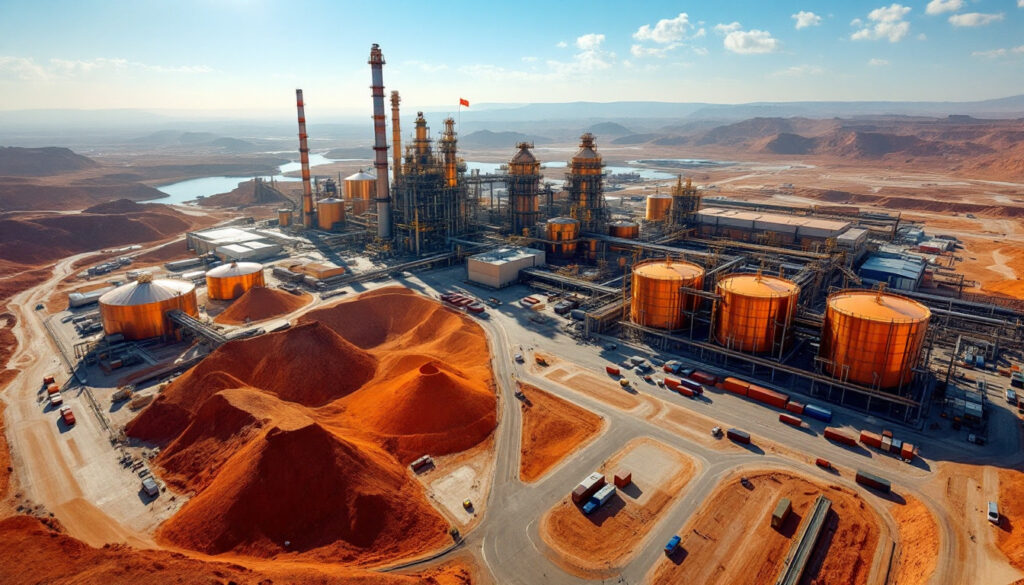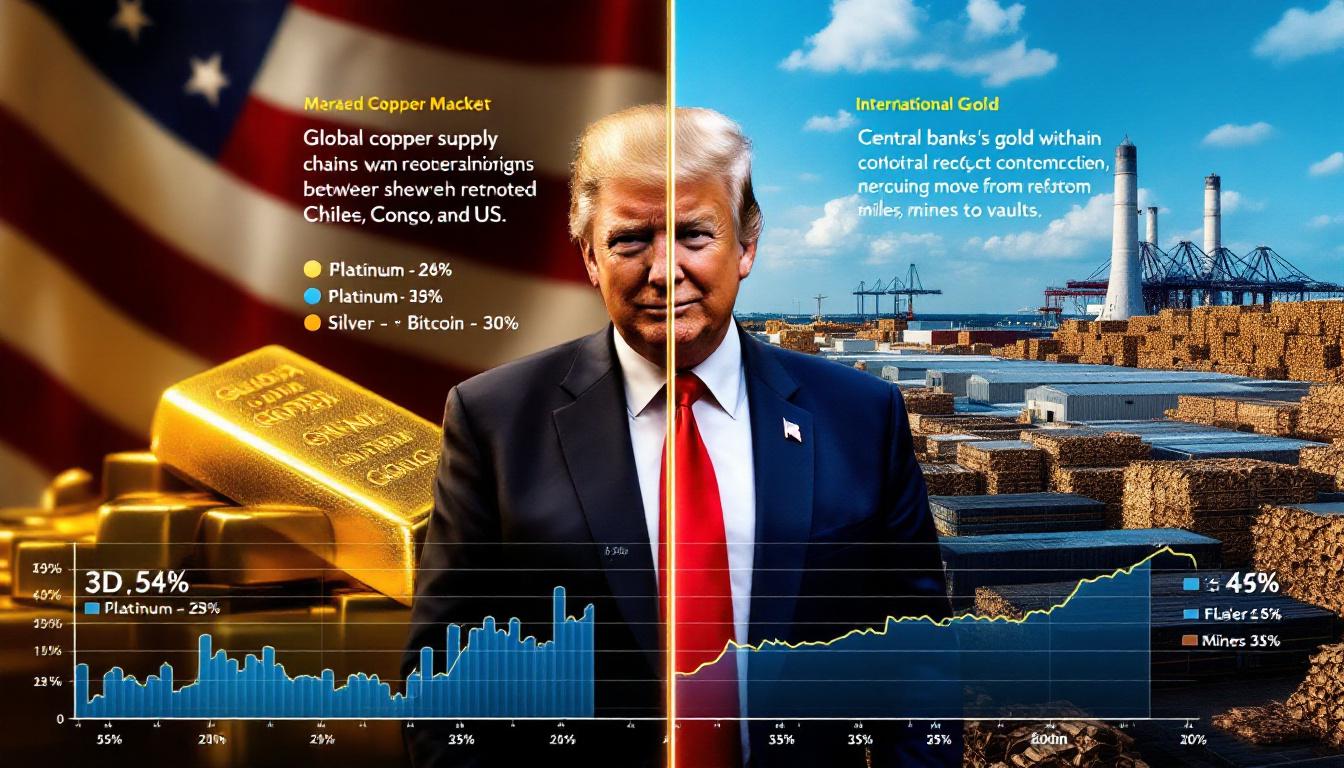How Has China Secured Over Half of Global Copper Processing Capacity?
The Current State of Global Copper Processing Distribution
China has established an unprecedented dominance in global copper processing, controlling 53% of worldwide capacity according to recent industry assessments. This concentration stands in stark contrast to the distribution among other major economies. The coalition of willing nations—including Canada, Western Europe, South Korea, and Japan—collectively represents the second-largest processing bloc, yet their combined capacity falls significantly short of China's commanding position.
The United States, despite its economic might, maintains a surprisingly small share of global copper processing infrastructure, creating a critical vulnerability in its industrial supply chain. This processing capacity distribution reveals a profound disconnect between where copper is extracted and where it is refined into usable forms for manufacturing and technology applications.
China's Strategic Approach to Securing Copper Processing Dominance
China's copper processing supremacy didn't happen by accident. Over the past two decades, Beijing has implemented a deliberate strategy of long-term investments in processing infrastructure while Western nations increasingly outsourced these capabilities. This approach has been characterized by extraordinary patience and foresight, with investments often taking 5-10 years to reach full operational capacity.
The cornerstone of China's success lies in its vertical integration strategy, methodically connecting mining operations to processing facilities through both direct ownership and strategic partnerships. This integration creates self-reinforcing economic advantages, with each segment of the supply chain supporting the others while capturing added value at every stage.
State-backed financing has been instrumental in this rapid expansion, with the China Development Bank and Export-Import Bank of China providing below-market capital for processing facilities both domestically and internationally. These financial mechanisms have enabled Chinese companies to expand capacity at a pace that commercially-financed Western competitors simply cannot match.
Beyond financial resources, China has systematically developed specialized technical expertise in copper smelting dynamics. The country now houses the world's largest concentration of metallurgical engineers specialized in copper refining, creating a knowledge base that further reinforces its competitive advantage in the sector.
Why Does the Extraction-Processing Imbalance Matter for Global Markets?
The Geographical Disconnect Between Extraction and Processing
A striking imbalance exists in the global copper industry: while US-aligned nations control approximately 50% of global copper extraction, they command only a fraction of processing capacity. This extraction is heavily concentrated in Chile and Peru, which together account for roughly 40% of global copper mining output, along with significant operations in the United States itself.
China, conversely, controls only about 30% of global copper extraction but dominates processing with its 53% market share. This creates a fundamental strategic vulnerability where resource-rich nations must export their raw materials to China for processing before they can be manufactured into finished products.
The Democratic Republic of Congo and Zambia represent particularly illustrative cases of this imbalance. Despite producing approximately 2.2 million tonnes of copper annually, these African nations have limited domestic processing capacity, forcing them to export concentrate to Chinese facilities and import refined copper at significantly higher prices.
The Economic and Strategic Implications of Processing Control
Processing capacity creates substantial pricing power in global markets. Refiners can adjust production levels to influence supply conditions, introducing price premiums during periods of high demand. This price-setting ability transfers economic value from extraction-focused countries to processing nations, often with little transparency in the pricing mechanisms.
The value-added economic benefits of processing are substantial. While extraction typically captures 30-40% of the final value of refined copper, processing and refining capture an additional 25-35%, with the remainder accruing to transportation and trading. This concentration of higher-value activities in China represents billions in lost economic opportunity for extraction-focused economies.
Supply chain vulnerability has become increasingly evident for manufacturing sectors dependent on processed copper, particularly in high-technology applications and renewable energy infrastructure. As Western nations accelerate their transitions toward electrification, their reliance on Chinese-processed copper creates significant exposure to supply disruptions, whether from geopolitical tensions or policy changes in Beijing.
Perhaps most concerning is the reduced negotiating leverage for extraction-focused countries. Without alternative processing options, mining nations must accept the terms offered by the limited number of large-scale refiners, most of which are now Chinese-controlled or influenced. This dependency undermines the ability of resource-rich nations to capture fair value for their natural endowments.
How Did China Establish Control Over African Copper Resources?
China's Strategic Investments in the African Copper Belt
China has systematically developed a commanding position in Africa's copper-rich regions, particularly across the prolific Copper Belt spanning the Democratic Republic of Congo and Zambia. This mineral-rich region produces some of the highest-grade copper ore in the world, with concentrations averaging 3.5-4.5% compared to the global average of 0.6-0.8%.
The Belt and Road Initiative (BRI) has served as the primary vehicle for this resource acquisition strategy, providing much-needed infrastructure development in exchange for preferential access to mineral resources. Since 2013, China has invested over $23 billion in African mining infrastructure, with approximately 40% concentrated in copper-rich regions.
A particularly effective approach has been China's willingness to build critical transportation infrastructure—including the $4.5 billion Tanzania-Zambia Railway—that connects previously isolated mineral deposits to global markets. These projects typically include concessional financing terms that secure preferential access to resources while creating meaningful economic benefits for host nations.
Perhaps most significant has been the transition of these copper-rich regions from "unaligned" to firmly within the "Chinese sphere" over the past two decades. Areas that previously maintained diversified trading relationships now conduct 65-80% of their mineral commerce with Chinese entities, representing a profound geopolitical realignment.
The Economic and Diplomatic Tools Used to Secure Resource Access
China's approach to securing African copper resources employs a sophisticated combination of economic incentives and diplomatic engagement. Infrastructure financing typically offers terms that Western institutions cannot match, including grace periods of 5-7 years, extended repayment schedules of 20-30 years, and interest rates 2-3 percentage points below commercial alternatives.
Technical assistance and knowledge transfer programs have been strategically deployed to address critical skills gaps in host nations. Chinese companies have established training centers that have certified over 12,000 local mining professionals across the Copper Belt since 2010, creating goodwill while ensuring operations meet Chinese technical requirements.
The creation of integrated supply chains from mine to market represents another cornerstone of China's strategy. By developing road, rail, and port infrastructure that connects directly to Chinese shipping routes, Beijing has created logistics networks that make Chinese buyers the natural destination for African copper exports, regardless of formal ownership arrangements.
Strategic diplomatic relationships reinforcing these economic ties extend beyond traditional government-to-government engagement. Chinese corporations maintain direct relationships with regional governors and local communities, often providing social infrastructure like hospitals and schools. This multi-layered approach creates complex dependency relationships that Western nations struggle to displace, even when offering competitive financial terms.
What Geopolitical Shifts Are Emerging in the Global Copper Market?
The Formation of Resource Blocs and Spheres of Influence
The global copper market is experiencing a transformation from an integrated global system toward three increasingly distinct spheres of influence. China, Russia, and America are emerging as the gravitational centers of these resource blocs, each seeking to secure critical mineral supply chains within their respective domains.
Previously neutral nations are facing mounting pressure to align with one of these major powers. Indonesia's recent pivot toward deeper mineral processing partnerships with China illustrates this dynamic, with Beijing offering $8.7 billion in integrated mining and processing investments that Western alternatives couldn't match.
India occupies a particularly interesting position in this evolving landscape. While maintaining its strategic autonomy, India has increased copper imports from Russia by 36% since 2022 while simultaneously developing processing joint ventures with Japanese and South Korean firms, demonstrating a sophisticated balancing approach between competing blocs.
Historical precedent suggests neutrality becomes increasingly difficult to maintain as resource competition intensifies. The experience of mineral-rich nations during previous periods of great power competition—from the Cold War to the colonial era—indicates that economic pragmatism eventually gives way to strategic alignment as powers compete for exclusive access to critical resources.
The Realignment of Supply Chains and Trading Relationships
Increasing regionalization of copper supply chains is already evident in trade flow data. Since 2020, intra-bloc copper trade has increased by 27% while cross-bloc commerce has declined by 18%, reflecting deliberate efforts to reduce dependencies on potentially hostile suppliers.
Strategic stockpiling by major economies represents another clear signal of this realignment. China's State Reserve Bureau has expanded its copper holdings by an estimated 300,000-400,000 tonnes annually since 2021, while the US Defense Logistics Agency has received congressional authorization to increase critical mineral reserves by $1.1 billion over the next five years.
The development of preferential trading arrangements within blocs further reinforces this fragmentation. China's "mineral security partnerships" with Central Asian nations offer pricing premiums of 5-8% above market rates in exchange for supply commitments that preclude sales to competing blocs during periods of market stress.
Perhaps most concerning is the emergence of parallel market systems with different pricing mechanisms. While the London Metal Exchange (LME) remains the global benchmark, the Shanghai Futures Exchange (SHFE) increasingly sets prices for the China-centered trading sphere, with growing indications that Russian copper is trading at differential pricing outside Western exchange mechanisms entirely.
How Might Western Nations Respond to China's Processing Dominance?
Potential Strategic Initiatives to Rebalance Processing Capacity
Western nations are beginning to implement coordinated investment strategies to rebalance global processing capacity. The United States, through its Inflation Reduction Act, has allocated approximately $7.5 billion toward critical mineral supply chains, with specific provisions for copper processing facilities. Similarly, the European Union's Critical Raw Materials Act aims to ensure 40% of strategic minerals are processed within EU borders by 2030.
Public-private partnerships represent the most promising vehicle for developing new processing facilities. The model pioneered by South Korea's POSCO, where government loan guarantees reduced capital costs by 22% while private sector expertise managed operations, offers a template for Western nations seeking to rebuild processing capabilities without direct state ownership.
Export controls on unprocessed copper represent a more controversial but potentially necessary policy lever. Chile's gradual implementation of export restrictions on concentrate is providing economic incentives for domestic processing expansion, with three new smelter projects now in development that will increase the country's refining capacity by 35% by 2027.
Technology development to improve processing efficiency offers another promising avenue. Advances in bioleaching techniques pioneered at Western universities have demonstrated the potential to reduce energy requirements by 26-31% compared to conventional smelting while simultaneously lowering capital costs by up to 40%. These innovations could help overcome China's current cost advantages.
Challenges in Developing Competitive Processing Capacity
Higher labor and environmental compliance costs in Western nations present significant challenges to rebuilding processing capacity. Operating expenses for US copper smelters exceed Chinese equivalents by approximately $320-380 per tonne, primarily due to stricter emissions controls and higher labor costs. This differential creates a substantial competitive hurdle for new facilities.
Lengthy permitting and approval processes further disadvantage Western capacity expansion. New processing facilities in North America face permitting timelines averaging 7-9 years compared to 2-3 years in China, creating substantial first-mover advantages for Chinese operators responding to market opportunities.
Technical expertise gaps after decades of outsourcing represent another formidable barrier. The average age of specialized metallurgists in Western copper processing operations is 58, with educational institutions producing fewer than 200 new qualified specialists annually—far below replacement needs as retirements accelerate.
Perhaps most challenging is the capital intensity and long payback periods for processing investments. New copper smelters require $15,000-20,000 of capital per tonne of annual capacity with payback periods exceeding 15 years at current margins. These economics are difficult to justify for publicly traded Western companies facing quarterly earnings pressures, in contrast to state-backed Chinese enterprises with longer investment horizons.
What Are the Investment Implications of Shifting Copper Processing Dynamics?
Opportunities in Emerging Processing Centers
Companies with integrated mine-to-processing operations are likely to command premium valuations as supply chain security becomes a strategic priority. Firms such as Freeport-McMoRan and Glencore, which maintain substantial processing capabilities within Western jurisdictions, have already seen their enterprise value/EBITDA multiples expand by 15-20% relative to pure mining companies since 2022.
The strategic importance of companies with processing assets in politically stable jurisdictions creates particularly compelling investment opportunities. Mid-sized processors in countries like Canada, Australia, and Chile that can serve as alternatives to Chinese refineries are attracting strategic investments from both technology firms and defense contractors seeking supply chain assurance.
Investment flows toward processing capacity expansion projects are accelerating, with capital raising for Western copper refining projects reaching $4.3 billion in 2023, more than triple the annual average from 2017-2021. These investments target not only traditional smelting operations but also emerging technologies like electrowinning and advanced hydrometallurgical processes.
Companies with technological advantages in processing efficiency are particularly well-positioned in this evolving landscape. Firms that can reduce energy consumption—the largest variable cost in refining—are achieving operating margins 22-28% higher than industry averages, creating substantial competitive advantages even in higher-cost Western jurisdictions.
Risk Factors in the Changing Copper Landscape
Supply chain disruption potential during geopolitical tensions represents a significant risk factor for copper-dependent industries. Gaming scenarios conducted by major industrial consumers suggest that even temporary interruptions in Chinese copper processing could create price spikes of 35-45% in refined copper products, potentially devastating margins for manufacturers without adequate hedging strategies.
Regulatory changes affecting cross-border copper flows appear increasingly likely as resource nationalism accelerates. Indonesia's implementation of export restrictions on unprocessed minerals serves as a concerning precedent, with at least seven other copper-producing nations now considering similar measures that could fundamentally alter established trade flows.
Price volatility during the transition to more regionalized markets creates both risks and opportunities for investors. The LME-SHFE price spread has widened from a historical average of 1-2% to periodic divergences exceeding 8% since 2022, creating arbitrage opportunities for traders while introducing significant hedging challenges for industrial consumers.
Strategic resource nationalism affecting existing operations remains perhaps the most concerning risk factor for long-term investors. The re-negotiation of mining contracts in countries including Panama, Mongolia, and Peru demonstrates how political calculations regarding strategic minerals can override previously established legal frameworks, creating unpredictable outcomes even for well-established operations.
How Might Future Copper Processing Capacity Be Distributed?
Projected Changes in Global Processing Distribution
Western nations are likely to make concerted efforts to build processing capacity, potentially reducing China's global share from 53% to 45-47% by 2030 according to industry projections. This rebalancing will not eliminate Chinese dominance but would create meaningful alternatives for copper-producing regions seeking more diversified relationships.
Significant processing expansion in "friendly shore" locations represents a pragmatic compromise between reshoring and continued offshoring. Countries like Mexico, Malaysia, and Vietnam—which maintain productive relationships with both Western economies and China—are attracting substantial investments in refining capacity as global firms seek to balance cost considerations with geopolitical risk management.
Strategic investments in processing technology to reduce capital requirements are accelerating, with Western firms allocating approximately $650 million annually to research and development of next-generation refining techniques. These investments focus on reducing both the up-front costs and long construction timelines that have disadvantaged Western capacity expansion.
The development of processing hubs in regions with secure access to raw materials represents another likely evolution of the global landscape. Chile's Antofagasta region and Arizona's copper triangle are emerging as integrated extraction-processing centers that minimize transportation costs and supply chain vulnerabilities while capturing more of the value chain locally.
The Role of Technology in Reshaping Processing Economics
Innovations reducing energy requirements for processing are fundamentally altering the economic equation for new facilities. Low-temperature bioleaching techniques pioneered by Western firms have demonstrated energy reductions of 38-42% compared to traditional pyrometallurgical processes, potentially eliminating much of China's cost advantage derived from lower energy prices.
Automation is steadily decreasing labor cost differentials between regions. Modern copper processing facilities can now operate with 40-50% fewer personnel than their predecessors from the early 2000s, reducing the impact of wage differentials between Western nations and China. This trend favors new facilities in Western jurisdictions where higher labor costs have historically created competitive disadvantages.
Advanced metallurgical processes are improving recovery rates, extracting more value from each tonne of concentrate processed. Techniques combining ultrafine grinding with sequential leaching have demonstrated recovery improvements of 3-5 percentage points compared to conventional methods, creating significant economic advantages for technologically advanced operations regardless of location.
Perhaps most promising for Western capacity development is the emergence of smaller-scale, modular processing facilities. These operations, with capacities of 50,000-100,000 tonnes annually (compared to traditional facilities of 300,000+ tonnes), require capital investments of $8,000-10,000 per tonne of capacity—roughly half the cost of conventional smelters. Their distributed nature also reduces permitting challenges and environmental impacts, creating viable economic models for Western jurisdictions despite higher operating costs.
FAQ About Global Copper Processing Dynamics
Why Is Copper Processing Strategically Important?
Copper plays an essential role in electrical infrastructure and renewable energy systems, with each megawatt of solar capacity requiring approximately 5 tonnes of copper. As global solar installations accelerate toward projected capacity of 500 GW annually by 2030, copper processing constraints could significantly impede decarbonization timelines.
The metal's critical role in electric vehicles further elevates its strategic importance. Each EV contains 80-85 kg of copper—roughly four times the amount in conventional vehicles—creating exponential demand growth as automotive electrification accelerates. Annual demand from this sector alone is projected to reach 4.5 million tonnes by 2030.
Military and defense applications requiring secure supply
Looking to Stay Ahead of Major Mineral Discoveries?
Discover potentially lucrative investment opportunities before the broader market by subscribing to Discovery Alert's proprietary Discovery IQ model, which provides real-time notifications of significant ASX mineral discoveries. Visit our discoveries page to explore how historic mineral discoveries have generated substantial returns for early investors.




